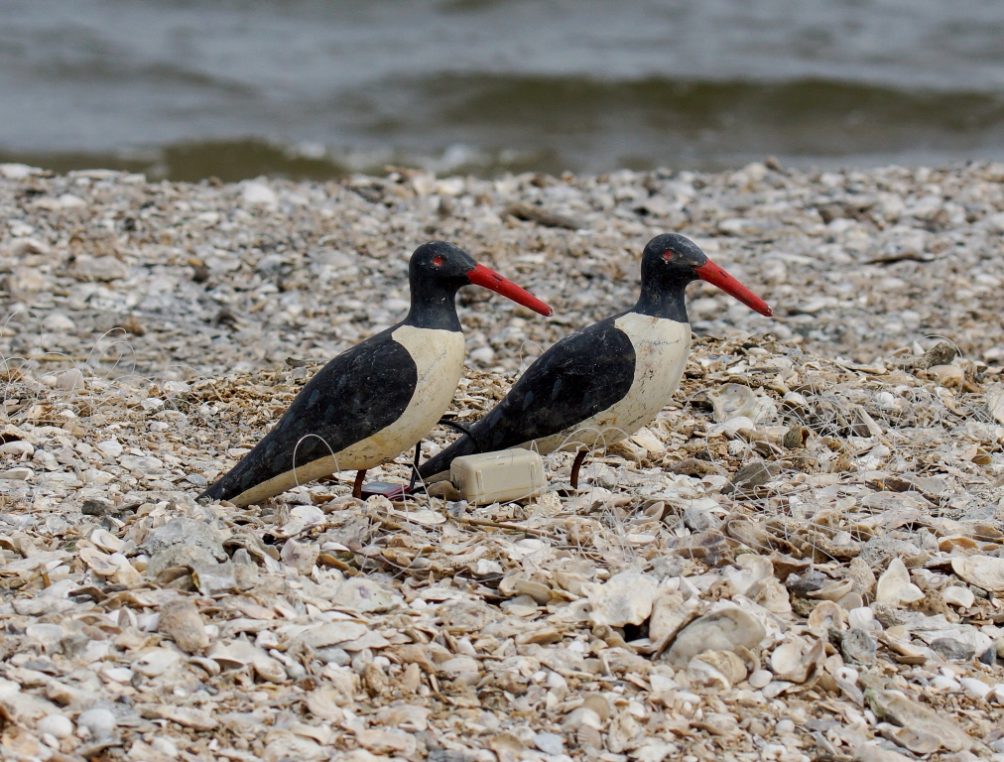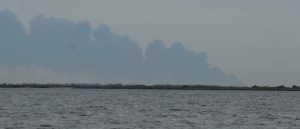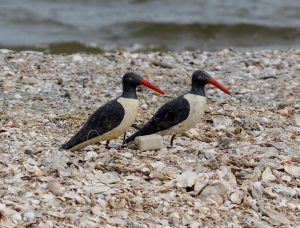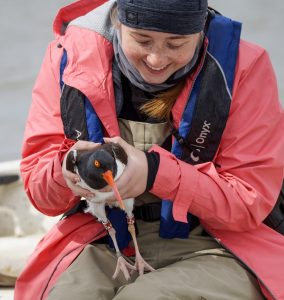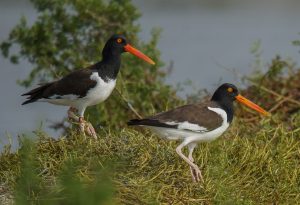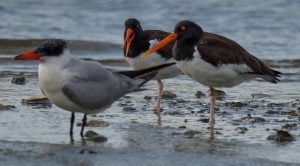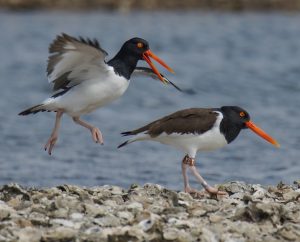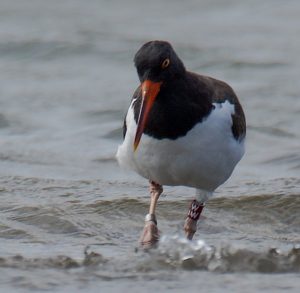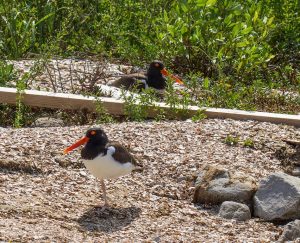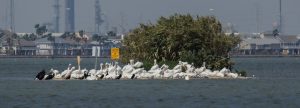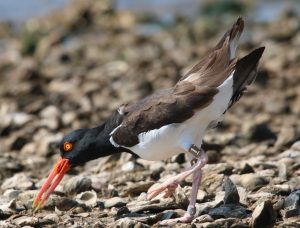By Susan Heath
On Monday, Alan, Kaitie, and I headed out to do some reef surveys in Bastrop and Drum Bays. Since we were out there anyway, we decided to check on a pair of oystercatchers that nests in the very west end of West Galveston Bay near Alligator Point. I don’t get out there much because it’s too far from the areas we regularly survey in West Galveston Bay. On the way there, we were flagged down by a Coast Guard boat. Never had that happen before! I was running through every regulation I could think of in my head trying to figure out what we’d done wrong but when they actually got up to us, they apologized and said they thought we were someone else. We spent some time afterwards theorizing as to what the people had done that they were looking for!
It was really clear and once we got out to the bay we could clearly see the smoke plume from the Deer Park fire even from nearly 40 miles away.
When we arrived at Alligator Point we didn’t see the pair we were looking for which really surprised me because I thought they’d have a nest. We found another pair on a reef nearby and discovered one of them was WT, a bird I banded as a chick in 2014. It hasn’t been seen since 2016 so that was a good find! We went back to the island and eagle eye Alan spotted the pair we were looking for in the first place. They acted like they had a nest but we couldn’t find one so we set up the noose carpets to try to get one of them banded.
Fred and Ethel (the decoys) did a great job and we caught the male. We banded him C0A.
We headed to Bastrop Bay and found J0 & 38 on their island but without a nest. We got the reef surveys done there and headed down to Drum Bay where we found JK & unbanded feeding on a reef. I thought they’d have a nest too but clearly they didn’t. While we were doing the reef surveys there, JT flew in and landed near us. I figured since JT was alone, his mate was on a nest somewhere but we couldn’t find her. I’m not quite sure where JT’s nesting now because his island has eroded too much for viable nesting and he moved somewhere else that I haven’t discovered. We didn’t see any other oystercatchers in that area so two pairs are missing.
On Tuesday, Alan and I took Haille Leija from Galveston Bay Foundation with us to survey West Galveston Bay. Haille is the lead on our Jones Bay restoration project and she wanted to get a better feel for the oystercatcher world. I think she got a full dose! As usual the wind was supposed to pick up later in the day but we didn’t have any fog for a change so we headed up to Swan Lake first thing. The pairs along the Galveston shoreline were both on their islands but neither had a nest. In Swan Lake we found that K7 & unbanded’s nest had hatched and they were doing their usual – hiding their chicks where we couldn’t see them. In fact we didn’t even see the adults when we arrived but they flew in from wherever they were hiding and gave us the business.
None of the other pairs up there had anything going on but 39’s mate was giving this Caspian Tern a good talking to. Not sure what he was saying but the tern seems unworried.
We headed back to West Galveston Bay and checked out Struve Luci and Jigsaw. HM & X7 were nowhere to be seen and I fear they are trying to nest in an unsavory location because their spot on the island is very low. I searched the Galveston Island shoreline through my binoculars but I didn’t see them. 12 & unbanded were still incubating and we found that L9 & unbanded have a nest now. Yeah! The other two pairs there didn’t seem to have anything going on. I watched KR & unbanded for quite a while to make sure they didn’t have a chick since they had a nest a few weeks ago. They were feeding along the shoreline and there wasn’t a chick toddling after them sadly. T5 & T6 were still incubating their nest but they only have one egg. You can do better than that guys! We interrupted a private moment for YE & unbanded which allowed me to verify that YE is a female!
We discovered W1W feeding on one of the reefs. That’s one of JR (now deceased) & JH’s chicks from last year on North Deer. Good to see it’s doing well.
At Gangs Bayou most of them were on the breakwater but we noticed a lone bird hanging out on the oyster balls that are near the shore of the island. I found that suspicious so we went to check. Ding, ding, ding! It was guarding a one egg nest.
We headed up to check on 16 & unbanded and couldn’t find them. Arg! Their nest failed too. It’s on the Galveston shoreline and so prone to mammalian predation. Poor birds. I thought they had a chance. Hopefully they’ll try again.
When we checked South Deer we found KK on a reef by himself. That’s the third time we’ve seen him there all by himself. Something is going on there and I don’t think it’s a good thing. I wonder if he lost his mate. So sad! Speaking of sad, HL & unbanded were out on a reef so the gulls must have gotten their eggs. LL & unbanded were still incubating though and we found that JN & UW had laid a new nest in a different location from the gull infested area where they laid their first one. Maybe this one will do better.
We got a couple surprises on North Deer. First we discovered that YM & JH had lost their nest from last week and had already laid a new one which had three eggs. Fast work guys! Then we discovered the unbanded pair at the west end also has a nest.
The other birds in that area haven’t started nesting yet so we tried the box on the nest in hopes of banding one of them. No dice though. They weren’t having any of that. Drat! W5 & unbanded were still hanging out in the new territory they carved for themselves. We are still waiting to see if they lay a nest there where no oystercatchers have nested before!
The pairs on Marker 52 were all still incubating except 28 & AP who are taking their time laying a nest. They fledged two chicks last year. Maybe they are taking a break this year. In Jones Bay we discovered P3’s island covered with white pelicans.
Could their chick have survived those giant feet? We saw a pair of oystercatchers hanging out on the backside of the island near some vegetation and away from the pelicans so we figured P3 & unbanded had their chick hidden there, but it turned out to be FR & unbanded. FR you dog! Did you take over P3’s island? That would be pretty unprecedented. Stay tuned for further details on that.
On Friday, Taylor and I checked out the oystercatchers in East Matagorda Bay. Well I should say we tried to check out the oystercatchers in East Matagorda Bay. We spent most of the day looking for and not finding oystercatchers. We only saw three oystercatchers all day and none of them had a nest. There are 10 pairs that regularly nest there. Where are they? 17 wasn’t too happy when we came to say hello.
We are once again adopting out oystercatcher pairs to support this project. If you adopt a pair, you will receive an adoption certificate for your birds and I will update you monthly on their progress throughout the breeding season. All adoption funds will be used to fund our work for the oystercatchers. If you’d just like to make a donation (thank you!) you can do so on our website here.
Current Stats for upper Texas coast from Dickinson Bay to East Matagorda Bay: 12 nests being incubated, 7 failed nests, 1 nest with unfledged chicks, 1 nest with undetermined status, 0 chicks fledged
Note: All trapping and banding for this project is in accordance with federal and state permits issued to Susan Heath, GCBO Director of Conservation Research. Bird handling by volunteers is only permitted in the presence of Susan Heath and volunteers are trained in proper bird handling techniques.

